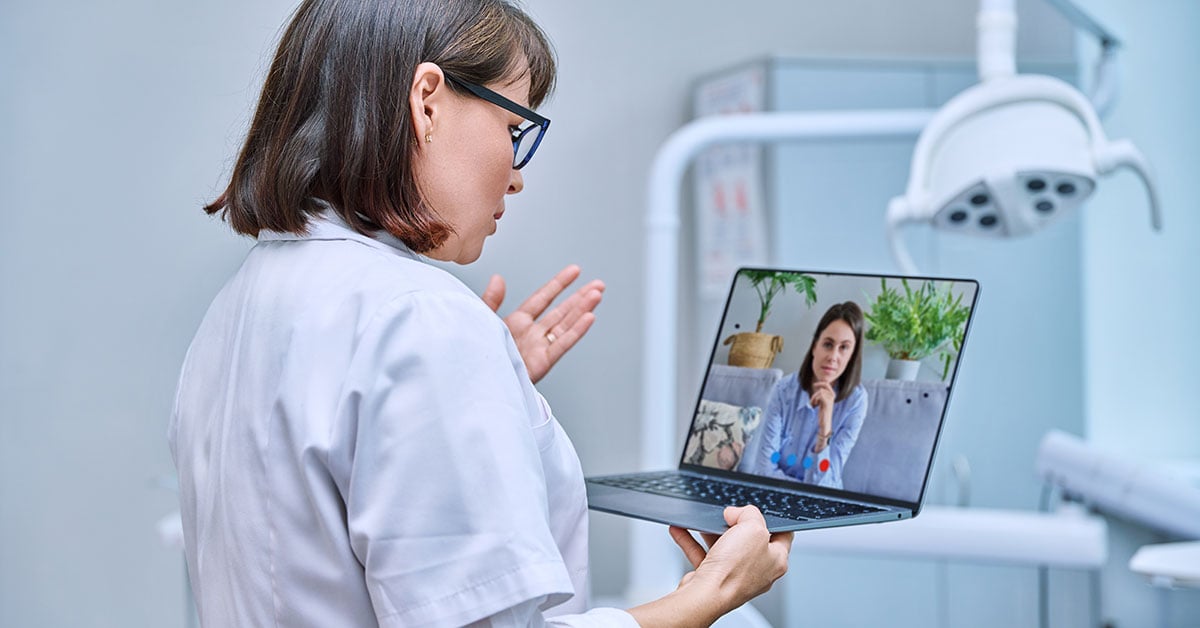“Cover-your-bases!” That thought applies across the board - especially when you’re launching something new. And for our purposes here it raises the question about liability and malpractice insurance for teledentistry.
You’re likely accustomed to covering your liability “bases” as a dental professional. While a malpractice scenario might lurk in the shadows you’ve probably put safeguards in place to counter any general threats.
But what about teledentistry and virtual consultations?
Legally speaking
Patient interactions and treatment protocols are expected to follow a very predictable path. But on occasion, something might go array.
Add teledentistry to the mix and you have one more service where liability could arise. A virtual consultation can and should be somewhat benign. Even so, it’s recommended that you (once again) cover-your-bases and proceed with the confidence of legal counsel or an insurance advisor.
In fact, we highly recommend seeking dental industry, legal, and insurance guidance.
What to expect from dental, legal, and insurance professionals regarding any potential for teledentistry liability or malpractice
Dental industry perspective
The broader telehealth environment (including teledentistry) is not free-range - in the sense of lacking guidelines or boundaries. For example, the American Dental Association (ADA) provides clear direction on the use of teledentistry in your dental practice.
The ADA covers a couple of key questions.
1-“Who has responsibility for services delivered via teledentistry?”
”Responsibility, and liability, for services delivered is determined by applicable state law and regulations. Each dentist, hygienist and others involved in a teledentistry appointment should become familiar with applicable state or federal regulations to determine their liability exposure, and whether or not the person receiving care becomes their patient of record. Please note that “patient of record” may be defined differently under applicable state regulations. This could be a factor to consider in a teledentistry event where the patient and some members of the team of providers are in different states.” [1]
2-How are you and your dental practice protected when providing teledentistry?
”…liability is determined by applicable state law and regulations. This concern should be discussed with your personal legal counsel and insurance advisor to determine whether or not your existing liability insurance policies cover this risk. Additional personal, professional and practice insurance coverage may be needed to address any coverage gaps.” [2]
Legal (malpractice) perspective
It helps to review and understand malpractice in general, its application to dentistry, and how it relates to teledentistry.
Here’s the general scope on malpractice:
”Malpractice is defined as a breach of the duty owed by an individual rendering professional services to another who has contracted for such services.” [3]
Let’s drill-down a bit deeper and define it for dentistry and teledentistry.
As relates to you, the dentist:
”Four elements necessary for malpractice to have occurred are 1) a duty of the dentist to act according to certain standards, 2) a breach of the applicable standard of care, 3) an injury to the patient, 4) casual connection between the breach of care and a patient’s injury.” [4]
Teledentistry malpractice could be defined in this way:
”For malpractice to occur in terms of teledentistry, there must be an consented, established relationship between the doctor and the patient, whether through e-mail or formal consultation. Then, the patient must give informed consent of the use of teledentistry. Next is the quality of care received by the patient. Most patients have acknowledged to receiving exceptional care through teledentistry, but this is a controversial topic with a national standard of care. The standard of care through teledentistry is different (oddly, much higher) than the standard of care for locally-cased care. This electronic standard of care carries more negligence and liability risks.” [5]
As with most professional relationships, communication is a core value. It’s crucial to seek to understand a patient’s need, communicate effectively, and provide your expertise.
Patient consent requires a clear understanding of treatment protocols, technology being used (including virtual/teledentistry platforms), and any related risks.
You’re accustomed to acknowledging accountability and liability for your skills, equipment/technology, and any trusted referrals.
Insurance perspective
Malpractice and liability insurance provisions for telemedicine/teledentistry can vary from company to company. Its availability has increased as virtual care solutions have evolved.
Keep in mind that some insurance companies lack understanding about how the telehealth environment works. You, as a dentist, get it but the application is easily lost on slow adopting insurance providers.
You limit and potentially eliminate your risks by taking responsibility for clarifying the scope of your practice’s malpractice/liability coverage. Proactive questions should include:
- Am I covered for telehealth/teledentistry services?
- Can a rider be added to my policy and at what cost?
If your current company doesn’t provide it or if adding it is cost prohibitive...
- Research insurance companies that provide telehealth/teledentistry service protection.
- Add them or switch your practice to them to cover your increased use of virtual care solutions.
Malpractice insurance costs for telemedicine/teledentistry can vary. One group associated with the growing teledentistry environment offers the following cost perspective:
”Policies seem to have a minimum premium of $ 5,000- $ 7,000 annually for limits of 1 Million per claim/ 3 Million in any one policy year total.
The approximate ‘price per consult’ is $ 1.00 -- $ 1.25 annual premium per consult for 1 Million / 3 Million policy with often no deductible. As the volume increases the ‘per consult’ premium goes down (at 150,000 consults, the premium would drop down to approximately .75 cents).” [6]
A firm commitment to teledentistry requires an equally firm resolve to cover-your-bases regarding any liability. Anything less will undermine your patient care standard and your innovations around the ongoing growth of virtual dental care opportunities.
A teledentistry solution that covers your virtual care innovations and helps keep you aware of ongoing guidelines
Stay on the innovative-edge of all things teledentistry. Check out these resources:
Why Teledentistry is a Here-to-Stay as a Sustainable Service
It’s Time for Teledentistry Adoption Inside and Outside the Pandemic Context
Teledentix is an innovative, turn-key teledentistry solution created by Virtual Dental Care. The all-in-one platform will enable you to adapt teledentistry to your patient care and extend your services beyond the walls of your dental practice…and improve your patient care in the process.
- Teledentix provides an easy-to-use video conferencing tool that’s secure, HIPAA compliant, and specific to dentistry.
- Teledentix Basic is a perfect starting point. Begin with a free trial and then transition to a very low monthly fee. You and your patients can join unlimited video conferences including screen-share, file-share, video-share, and real-time chat communications.
LEARN MORE about the Teledentix platform.
[1] https://www.ada.org/
[2] https://www.ada.org/
[3] https://lr00177158.wordpress.com/legal-aspects-2/malpractice/
[4] https://lr00177158.wordpress.com/legal-aspects-2/malpractice/
[5] https://lr00177158.wordpress.com/legal-aspects-2/malpractice/
[6] https://www.doctorsagency.com/blog/are-you-starting-a-small-teledentistry-company



